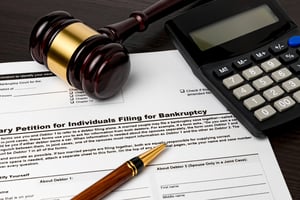 In a chapter 13 bankruptcy case, a person makes payments towards their debts in a three to five year repayment plan. In most cases, the debtor pays only a fraction of their total debt. After successfully completing their repayment plan at the end of three to five years, the debtor receives a discharge which relieves them from any further responsibility to pay their remaining debts, with limited exceptions. Chapter 13 bankruptcy often affords a tremendous amount of financial relief for those who are struggling to pay their debts and make ends meet.
In a chapter 13 bankruptcy case, a person makes payments towards their debts in a three to five year repayment plan. In most cases, the debtor pays only a fraction of their total debt. After successfully completing their repayment plan at the end of three to five years, the debtor receives a discharge which relieves them from any further responsibility to pay their remaining debts, with limited exceptions. Chapter 13 bankruptcy often affords a tremendous amount of financial relief for those who are struggling to pay their debts and make ends meet.
Generally speaking, any individual person with a regular income may file a chapter 13 bankruptcy case, absent limited exceptions. One exception is that a person may not file a chapter 13 bankruptcy case if they have more than $465,275 in unsecured debts (i.e. credit cards, medical bills, personal loans, etc.) or more than $1,395,875 in secured debts, such as home mortgages and car loans. Another exception is that a person may not be able to file a chapter 13 bankruptcy, and receive a discharge, if they filed a previous chapter 7 or chapter 13 case in the recent past. A person may not file a chapter 13 and receive a discharge of debts if they have filed a chapter 7 case within the last 4 years, if they received a discharge in the previous chapter 7 case. A person may also not file a chapter 13 and receive a discharge if they filed a previous chapter 13 case within the last two years and received a discharge in the previous case (a bit odd since chapter 13 cases last three to five years, with very few exceptions). It is important to note that a debtor is not prevented from filing a chapter 13 case, and receiving a discharge, if they did not receive a discharge in their previous bankruptcy case. Also important to understand is that a debtor is actually permitted to file a chapter 13 case, at any time, without regard to a previous bankruptcy case in which they received a discharge. However, in such cases where the debtor files a chapter 13 case less than 4 years from their previous chapter 7 filing, and less than 2 years from their previous chapter 13 case, they are not able to be granted a discharge by the court. Sometimes, a debtor may choose to file a chapter 13 case even though they will not be granted a discharge due to a previous bankruptcy case, for the purpose of gaining the relief of the automatic stay against creditors, and to be able to have a structured affordable monthly payment towards their debts.
Chapter 13 repayment plans can be difficult to successfully complete due to the fact that they last three to five years and the fact that the debtor must contribute all of their disposable income (the remaining income they have after paying all their basic expenses), each month, throughout the entire plan. For this reason, chapter 13 cases are frequently dismissed, either voluntarily by the debtor, or by the court, when the debtor becomes unable to continue making payments. Fortunately, the bankruptcy courts understand this and are fairly generous about allowing debtors to refile a chapter 13 after a previous case has been dismissed. Generally, there is not a time limit that a debtor must wait to file a new chapter 13 case after a previous case has been dismissed. An exception to this rule is when the debtor voluntarily dismisses their chapter 13 case in response to a creditor’s motion for relief or to avoid complying with an order of the bankruptcy court. In these cases, the debtor may not refile their chapter 13 case less than 180 days from when their chapter 13 case was dismissed.
Another limitation on a person’s ability to refile a chapter 13 case after having a previous chapter 13 case dismissed is that the debtor may not file a chapter 13 case in “bad faith.” For example, a debtor files a bankruptcy case in bad faith when they do so simply to defraud their creditors without a legitimate expectation of successfully being able to complete their case. A debtor who repeatedly files a chapter 13 bankruptcy case to gain the benefit of the automatic stay against a creditor’s collection efforts without the financial means of being able to make their monthly bankruptcy payments would be filing their case in bad faith. For this reason, the bankruptcy code provides that a person who files a chapter 13 case within one year of having a previous chapter 13 case dismissed is only provided the benefit of the automatic stay for 30 days from the date their case is filed. In order for the debtor have the automatic stay continued past this initial 30 day period, they must file a motion asking the court to keep the stay in place, and will succeed on the motion only if they can prove to the court that their bankruptcy case was not filed in bad faith. A debtor who files a chapter 13 case after having two, or more, chapter 13 cases dismissed in the previous year, does not automatically get the protection of the automatic stay upon the filing of their case, at all. In these types of cases, the debtor must file a motion asking the court to impose the automatic stay, which also must show the court that their current chapter 13 case was not filed in bad faith.
CALL NOW FOR A FREE STRATEGY SESSION FROM A MN BANKRUPTCY LAWYER AT LIFEBACK LAW FIRM
A chapter 13 case is a great opportunity for people who are struggling to pay their debts to manage their debts in an affordable manner while receiving protection from their creditors from the bankruptcy court. A person who is considering filing a chapter 13 bankruptcy case should first consult with an experienced bankruptcy attorney, as bankruptcy law can be complicated, and talking to a bankruptcy lawyer is the best way to ensure one has the best opportunity to successfully complete their plan. LifeBack Law Firm P.A. now has a brand new office located at 370 Selby Ave., Suite 224, Saint Paul Minnesota 55102. Come see us there or visit us at lifebacklaw.com!


